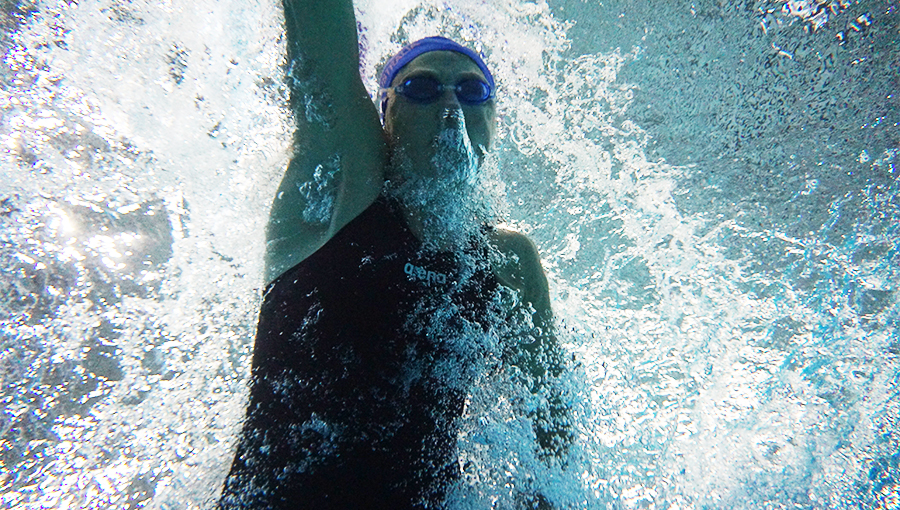 Born to race! Jenny Whiteley is the current FINA World Record holder for the womens 50m freestyle for her age group.
Born to race! Jenny Whiteley is the current FINA World Record holder for the womens 50m freestyle for her age group.
Racing. It’s all about the pacing!
Even in a 50 metre race, for masters swimmers, there is the need for some thought as to how you expend your effort across the whole race. When you get to 100 and 200 metre races – or longer – it becomes even more important.
You spend countless hours training, you spend time and effort on refining your technique, you practice your starts and turns, you eat well and sleep well – and yet you can potentially throw all of this away with incorrect pacing.
Article by Sally Bell.
What is incorrect pacing?
Well, in almost all situations, it means going out too hard, i.e. expending too much energy in the first lap and/or first half of a race, so that you become so much slower in the latter part of the race. You might have experienced this yourself at some stage – your stroke falls apart and becomes inefficient, you put your body under stress, and there’s no way you can find the energy to finish hard over the last 20 metres.
Basically, it feels horrible – particularly in butterfly – and physiologically it is not the way to get the optimum performance out of your body. This has been proven again and again both by specialists in the area and by swimmers’ successes and mistakes.
So how do you know what correct pacing is?
There are a number of “rules of thumb” which will help you swim your races at optimal pace for peak performance.
- For a 50 metre race
When you surface from your dive, don’t immediately go into a flurry of top effort sprint strokes. Make sure your first three or four strokes are technically correct, powerful and allow you to build to your top race pace so that you can sprint right to the wall… not fall in a hole in the last 10 metres.
- For a 100 metre race
Your first 50 should be no less than 2 seconds slower than your straight 50 metre time. Your second 50 should be no morethan 4 seconds slower than your first 50 – if it’s more than this, you’ve gone out too hard.
- For a 200 metre race
Your first 50 should be no less than 3 seconds slower than your straight 50 metre time. Your remaining three 50s should all be of similar pace, with the last 50 being your second fastest 50 (as your first 50 is likely to always be your fastest – no matter how “easy” you go!)
Your first 50 in a 200 should feel like you are not even racing. Concentrate wholly on long, strong strokes, and possibly breathing less than you usually do (e.g. every 4 instead of every 2). You will still do a quick time – one that is probably only a couple of seconds slower than your 50 race pace – but you will have expended so much less energy to do it, and that is the key point.
“It never ceases to amaze me that I can do a flat out 50 race in – say – 33 seconds, and yet I can do the first lap of a 100 in 35 seconds going really, really easy. It just goes to show – you can afford to really take it easy in the first lap – easier than you think you can – and still do a fast time. Going just a half a second slower in the first lap can mean a lot of energy spared, and a lot more energy available to come home fast and strong”
Real life examples – the Wall of Shame and Pain
-
Yep, even the great James Magnussen can get it wrong.
So much so, he can even risk his position on a Commonwealth Games team. In the recent Trials, James was favourite to take out the “blue riband” event, as they call it – the 100 metre Freestyle. But he was beaten by lesser known Cameron McEvoy – and here’s why.
In the semi-finals, James did his first lap in 23.14, and his second lap in 24.69 (“not at full effort”, he said), for a wonderful 100 metre time of 47.83 – securing him top qualifier and favourite for the final.
However, in the final, James did his first lap in a blistering 22.76… and his second lap in 25.16 (slower than his “easy” semi swim), for a slower final time of 47.92… and a silver, not gold, medal.
To put this in context – James’ time in the individual 50 Freestyle final was 22.02. However he swam the first lap of a 100 Freestyle – touching with his feet – only 0.74 seconds slower than his flat-out 50. This is too fast for a body to handle, in order for that body to be able to swim an optimal second lap. It might be just milliseconds, but for James it meant a world of difference.
-
Breaststroker 1 vs. Breaststroker 2 – 2013 State Masters Champs
To protect the innocent, and the not-so-innocent, I have concealed the identities of these two swimmers in the fastest heat of last year’s State Masters 200 Breaststroke. Here are their splits:
| 50 metre splits | 100 metre splits | 200 time | |
| B1 | 34.31 | ||
| 39.79 | 1.14.10 | ||
| 44.10 | |||
| 44.90 | 1.29.00 | 2.43.10 | |
| B2 | 37.12 | ||
| 43.19 | 1.20.31 | ||
| 41.74 | |||
| 41.44 | 1.22.18 | 2.42.49 |
Yes, B2 won – he powered past the hapless B1 as his arms and legs refused to work for him and he could no longer breathe.
In fact, B1 did not come back to compete the following day.
B1’s first 50 time – 34.31 – was less than half a second slower than his individual 50 breaststroke time. No-one’s body will allow their owner to do this in the first lap of a 200 and live to tell the tale. You cannot deny your body’s physiology; don’t let anyone tell you that you “have to get out there”. You’ll hear TV commentators say this, and it’s never, ever the right thing to do.
I have no doubt that B1 was very, very capable of beating B2 – in fact, if he had paced his race correctly, he may well have swum three or four (or more!) seconds faster than he did.
Instead of swimming 34.31 for his first 50, if he had swum, say 35.5 or 36.0, it would have been incredibly easy… and he would have conserved a huge amount of energy, which would have had a massive impact on the times he swam for his remaining 50s. Not to mention, he would have been able to keep his stroke long and strong, and not shorten up and tighten, like he did.
I could go on about this for pages and pages and give you endless examples, but I hope that gives you enough information to change the way you race – forever!
Sally Bell

